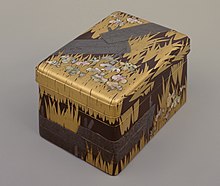
Back أواني اللك اليابانية Arabic Yapon lak məmulatı Azerbaijani Lacat japonès Catalan Laqueado japonés Spanish Laque japonaise French Seapánach (laicear) Irish 日本の漆器 Japanese ജാപ്പനീസ് ലാക്വർവെയർ Malayalam Japans lakwerk Dutch Laca japonesa Portuguese


Lacquerware (漆器, shikki) is a Japanese craft with a wide range of fine and decorative arts, as lacquer has been used in urushi-e, prints, and on a wide variety of objects from Buddha statues to bento boxes for food.
The characteristic of Japanese lacquerware is the diversity of lacquerware using a decoration technique called maki-e (蒔絵) in which metal powder is sprinkled to attach to lacquer. The invention of various maki-e techniques in Japanese history expanded artistic expression, and various tools and works of art such as inro are highly decorative.[1]
A number of terms are used in Japanese to refer to lacquerware. Shikki (漆器) means "lacquer ware" in the most literal sense, while nurimono (塗物) means "coated things", and urushi-nuri (漆塗) means "lacquer coating."[2]
The terms related to lacquer or lacquerware such as "Japanning", "Urushiol" and "maque" which means lacquer in Mexican Spanish, are derived from Japanese lacquerware.[3][4]
- ^ Masayuki Murata. 明治工芸入門 p.24. Me no Me, 2017 ISBN 978-4907211110
- ^ Urushi-nuri at JAANUS - Japanese Architecture and Art Net Users System
- ^ Ted J.J. Leyenaar. "Mexican lacquers from Guerrero /La laca Mexicana de Guerrero" (PDF). Netherlands: National Museum of Ethnology Museum Volkenkunde. Archived from the original (PDF) on December 13, 2014. Retrieved June 10, 2015.
- ^ Kathryn Santner (October 2, 2012). "Writ in Lacquer: A Genteel Courtship on a Mexican Sewing Box". Los Angeles: Los Angeles County Museum of Art. Retrieved June 10, 2015.
© MMXXIII Rich X Search. We shall prevail. All rights reserved. Rich X Search